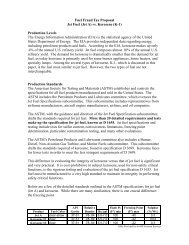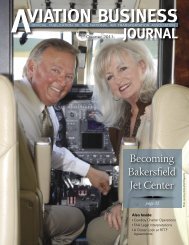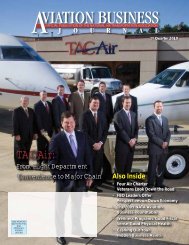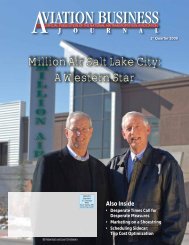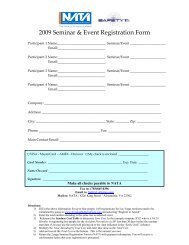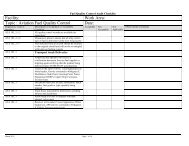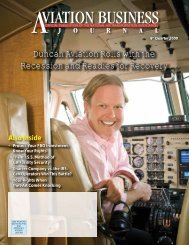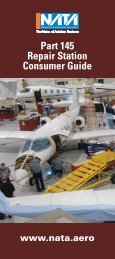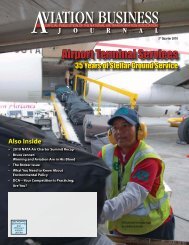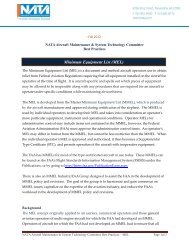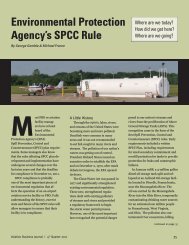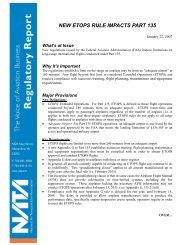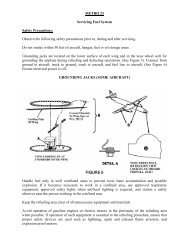Computer-Based Maintenance Tracking Flight Training ... - NATA
Computer-Based Maintenance Tracking Flight Training ... - NATA
Computer-Based Maintenance Tracking Flight Training ... - NATA
- No tags were found...
Create successful ePaper yourself
Turn your PDF publications into a flip-book with our unique Google optimized e-Paper software.
When Can an On-Demand CharterReally Be a Scheduled <strong>Flight</strong>?By Jacqueline RosserAt the recent 2007 <strong>NATA</strong> Air Charter Summit,jaws dropped when an attorney withthe Federal Aviation Administration (FAA)explained to attendees that the mannerin which many empty legs are posted orotherwise offered to the public may infact violate the FAA’s rules prohibiting scheduledservice in turbojet-powered aircraft under Part 135.As part of a broader discussion involving thefuture of brokers, Joe Conte, manager of the operationslaw branch within the FAA Chief Counsel’soffice, touched on a subject gaining attention withinthe agency: defining what is and, more importantlyfor Part 135 operators, what is not a schedule. Inrecent years, operators have found methods toalert consumers to available empty-leg flights (alsocalled positioning, one-ways, and deadheads). Butoperators should proceed with caution because,according to Conte and a 2006 FAA legal interpretation,these flights may in fact meet the definitionof a “schedule” and therefore must be conductedunder Part 121 if a turbojet-powered airplane or anairplane with more than 9 passenger seats is used.Current regulations define a scheduled operationas one where the operator holds out to the public,in advance, the departure location, departure time,and arrival location. In the 2006 interpretation, theFAA expanded upon what conditions might lead toa determination that an on-demand operator hasconducted an operation meeting the three elementsof a schedule. This interpretation as well as otherrelevant FAA legal interpretations are available fordownload at www.nata.aero/emptylegs.During his presentation, Conte noted that whenan on-demand operator offers the use of an “idleaircraft” that includes a relatively brief departurewindow and if the operator states the locationwhere the aircraft must arrive, the FAA will likelyconsider the operator to have “held out” the flightand to have operated on a scheduled basis. Importantly,beginning with the introduction of Part 119,all scheduled operations using turbojet-poweredaircraft (or using any piston or turbo-prop airplanewith more than 9 passenger seats) must be conductedunder Part 121.In 1997, a new set of FAA regulations took effectthat dramatically changed the regulatory environmentfor all air carriers. Commonly known as the“Commuter Rule,” the new 14 CFR 119 (Part 119)reclassified the certification and operations specificationsrequirements for air carriers. The mostsignificant change was that scheduled commuteroperators previously operating under Part 135 weretransitioned to Part 121. As part of this transition,the FAA restricted the ability of Part 135 on-demandoperators to conduct even occasional scheduledoperations. Under today’s rules, an on-demand operatormay conduct scheduled flights in an airplaneunder these limited conditions:1. The airplane used must be piston- or turboproppowered,2. The airplane used must have a maximum seatingcapacity of 9 passenger seats or fewer,3. The airplane used must have a maximum payloadof 7,500 pounds or less, and4. The operator is limited to conducting fewerthan five round trips per week between any twopoints.Therefore, whenever a turbojet-powered airplaneis to be used in an operation that meets the defini-Continued on page 26Aviation Business Journal | 3 rd Quarter 200725


